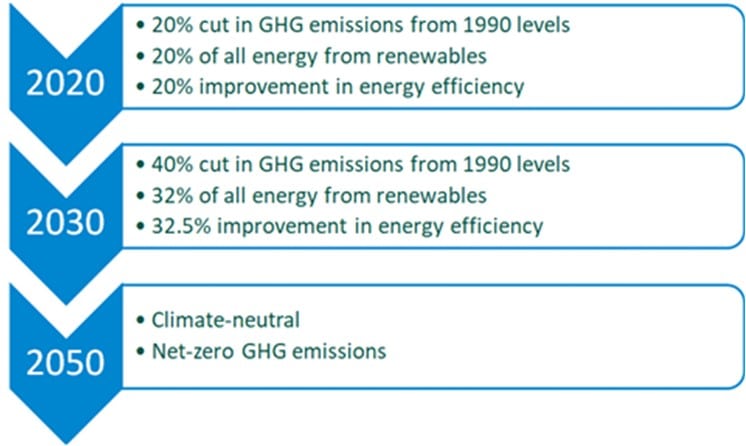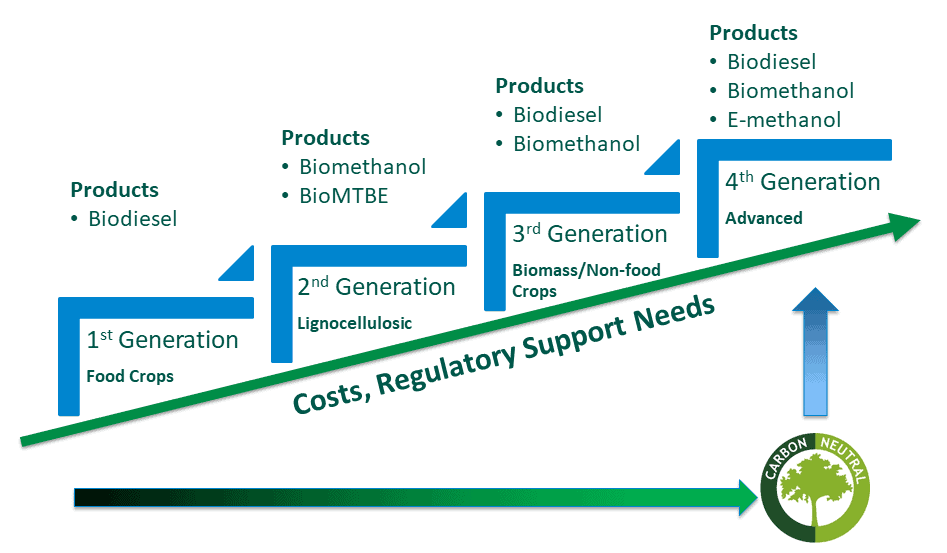Efforts to utilize methanol as a fuel for transportation have taken place globally since the early 20th century, and until recently these have proven difficult economically. Global efforts are underway to lower the world’s emissions of CO2 in creating power needed for future societies, and methanol finds itself in the middle of many different possible solutions. While the markets for this use may be far off, continued commercial interest is underway. MMSA continues to develop a techno-economic assessment of these markets; please contact MMSA for further details.

The graphic above summarizes climate change policy in the EU, where “net zero” GHG emissions are sought. These are collective regional targets with degrees of freedom offered to member states to implement domestic programs. Transport is the highest CO2 emitting energy sector and various reduction programs are in place across the EU to meet the overarching goals. Each has a different means of arriving at the final goals, with some requiring that certain entities purchase credits for certified fuel types, and others focused on mandating the use of these fuels. The US has been focused on the use of a system obligating parties to use lower CO2 intense fuels (Renewable Fuel Standard), with some early efforts (esp. CA) to migrate toward an absolute CO2 reduction requirement.
As these regulations evolve, methanol finds itself in the middle of potential solutions. The diagram below shows how fuels are currently being conceived towards a carbon-neutral pathway. Moving from left to right, the fuels move from “first generation” crop-based sources, which if used exclusively would create biodiversity risks and competition with food supply, to lower risk crops, waste and biomass sources and “advanced” fuels. These utilize renewable sources of power to create hydrogen to react with sequestered CO2 to great low-carbon fuels. Methanol can be used across platforms in the form of biomethanol (made from biogas or from biomass), biodiesel (from vegetable oils and animal fats), bioMTBE (from biomethanol and/or bio C4s), and eventually, “e”-methanol, made from renewable power sources. In fact, methanol can also be used to make “bio” versions of derivatives (olefins, formaldehyde, acetic acid, etc.) depending on regulations and support.

Such fuels are the beginnings of those envisioned by authors of the Methanol Economy (with claimants to that title in both the US and Germany). Theoretically, a “benign cycle” is possible whereby man uses solar, wind, geothermal, even “safe” nuclear power with methanol as a carrier of hydrogen to places needed, and only small increments of fossil fuels needed to expand methanol supply, only to recover emitted CO2 once again using methanol. Of course, these markets remain elusive and of questionable (yet potentially massive) market size and will become more costly moving toward the 4th generation. MMSA has been a thought leader in this area starting with its annual Methanol Policy and Technology Conference in Frankfurt and is glad to discuss its thoughts on these radically different markets with clients.
